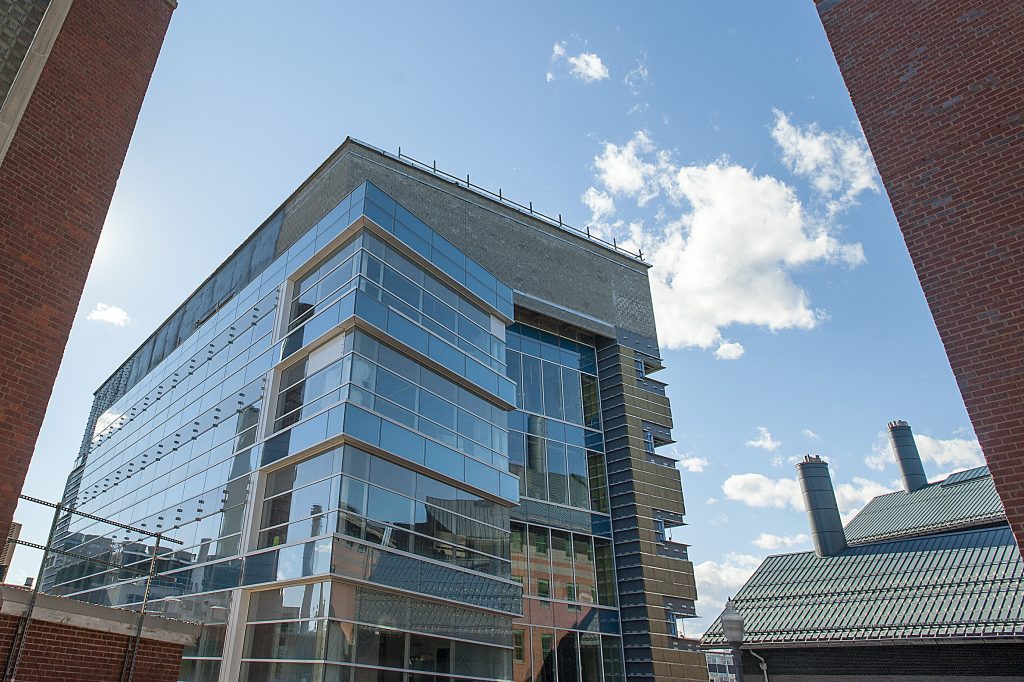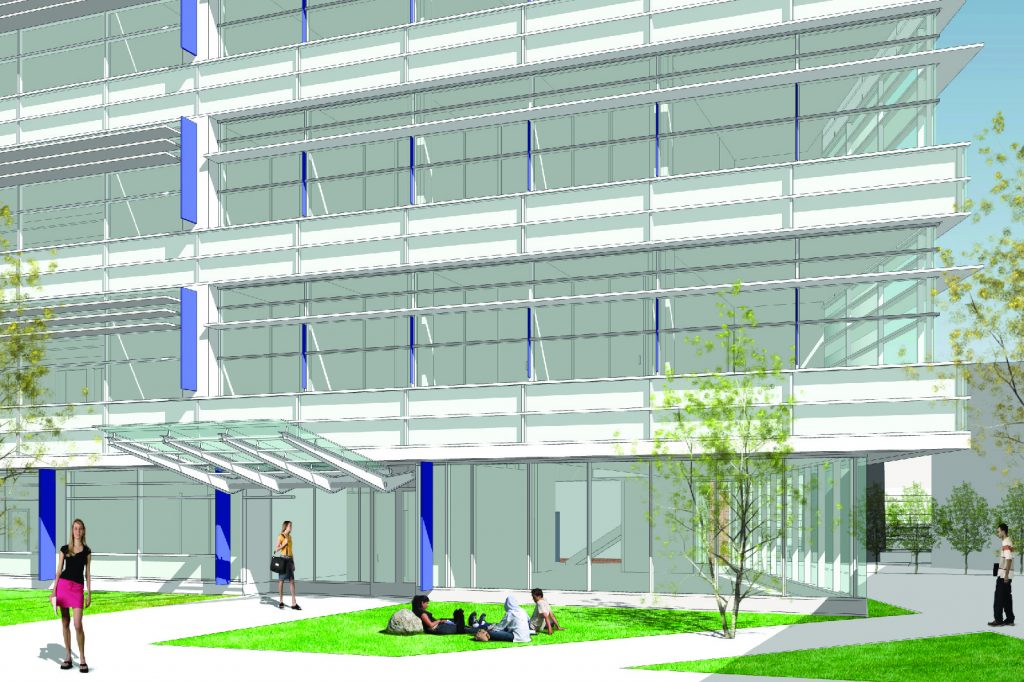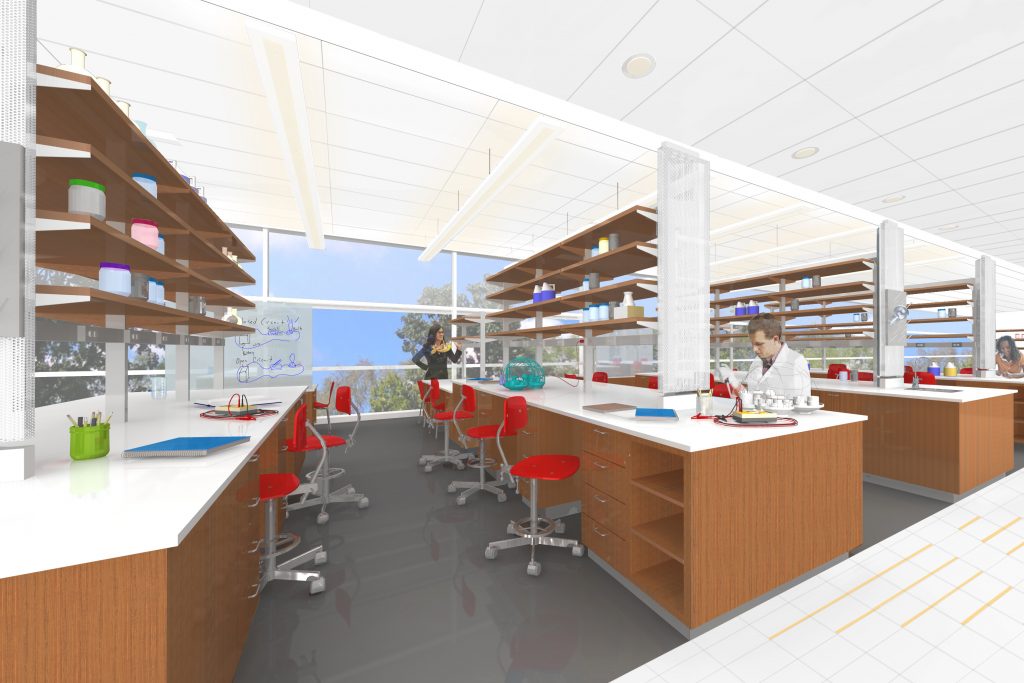
When UConn’s new Engineering and Science Building opens this fall, it will provide room for some of the university’s fastest growing research fields – systems genomics, biomedical sciences, robotics, cyber-physical systems (think drones) and virtual reality technology.
The five-story building, under construction since September 2015, is approximately 75 percent complete, according to Brian Gore, UConn’s director of infrastructure and program management. Researchers will move in to the new space this summer, beginning in July.
Located behind Student Health Services and the Chemistry building in North Campus, the Engineering and Science Building will be the first structure on the Storrs campus to utilize an “open lab” concept for research. The shared research space and open floor plan is intended to make it easier for scientists from different disciplines to collaborate, fostering innovation.

The new structure also gives scientists access to a high-speed broadband network that delivers the capacity they need to process large amounts of data quickly – a necessity in many research fields today.
“It’s exciting,’ says Professor Rachel O’Neill, a molecular genetics scientist and director of UConn’s Center for Genome Innovation, which is moving into the new building. “We hope this will increase the already vibrant synergy among these faculty and foster strong, productive collaborations and interactions.”
Read about O’Neill’s research here.
There will be plenty of opportunities for graduate students and students pursuing advanced degrees to conduct research in the new building. The Engineering and Science Building’s core mission is to support UConn’s role as a vital state resource, fueling Connecticut’s economy with innovative technologies and highly skilled graduates, and helping to create high-paying jobs.

The School of Engineering occupies three of the five floors. The second and third floors will house UConn’s Institute for Systems Genomics and related programs.
The new building addresses a pressing need for space within the School of Engineering, where enrollment has doubled over the past decade. The school recently hired more than 30 faculty to expand its research efforts and teaching staff. In addition, UConn’s School of Engineering supports numerous partnerships with world-class manufacturers, such as General Electric, Pratt & Whitney, Fraunhofer, Comcast, and FEI.
Here is a breakdown of the building’s future tenants:
First Floor:
Robotics and Controls Lab. An advanced, interdisciplinary, engineering lab developing tools to improve the efficiency and safety of robots used in manufacturing and other industries.
Computational Design Lab. A virtual reality research lab advancing new haptic technologies (haptics is the science of applying touch sensation and control in human interactions with computers, e.g. vibrations in smart phones and video games) and gesture recognition technologies for 3-D applications.
Adaptive systems, Intelligence, and Mechantronics Lab and Laboratory of Intelligent Networks and Knowledge-perception Systems. These labs focus on the development of new technologies and sensors for adaptive and intelligent autonomous vehicles (e.g. drones) and other systems.
Manufacturing Systems Laboratory. This lab’s mission is to advance technologies toward the development of ‘smart’ and ‘green’ buildings that optimize energy consumption, conserve resources, and enhance efficiencies.
Second and Third Floors:
Institute for Systems Genomics. UConn’s premiere genomics research and training program. Includes faculty from multiple disciplines: molecular & cell biology, ecology and evolutionary biology, allied health sciences, and UConn Health. Offices for researchers from UConn Health’s Department of Genetics and Genome Sciences will be included in this space, emphasizing the cross-campus collaborative nature of the research area.
Center for Genome Innovation. The core service and training center for UConn’s genomics and cytogenetics programs. The new space will feature some of the latest instrumentation for Next Generation genome sequencing, analysis, and genotyping. The CGI supports more than 120 labs at UConn campuses in Storrs, Farmington, and Avery Point and provides services for clients outside of UConn.
Microbial Analysis, Resources, and Services (MARS) – This core facility assists researchers by performing microbiome, targeted amplicon, and small genome sequencing.
Computational Biology Core. This core group provides crucial computational power and technical support to UConn researchers and affiliates. The CBC is led by assistant professor Jill Wegrzyn, who recently helped decipher the largest genome sequenced and assembled to date – the sugar pine tree.
Professional Science Master’s in Genetic and Genomic Counseling programs. Affiliated with Allied Health Sciences, these new programs will teach students how to interpret genetic testing results, a rapidly growing aspect of health care.
Fourth Floor:
Cellular Mechanics Laboratory. This lab investigates how changes in the biomechanical properties of cells influence the onset and progression of sickle cell disease.
Biointegrated Materials and Devices at Nano- and Micro-scales. Research here focuses on the development of materials, devices, and systems at extremely small scale for applications in biomedicine.
Neuroengineering and Pain Research. This lab focuses on sensory coding and processing in the peripheral nervous system with a goal of developing Next Generation strategies and devices for better management of chronic pain.
Microelectromechanical systems for biomedical analysis. Researchers use nano- and micro-scale optical imaging and mechanical sensing for the biomedical analysis of cancer cells.
Smart Imaging. This lab’s core mission is the development of novel imaging and sensing tools to tackle measurement problems in biology, medicine, and metrology including lab-on-a-chip platforms.
Interdisciplinary Mechanics. This lab uses computational modeling and experimental testing to solve challenging problems in biomechanics and engineering related to soft biological tissues, new materials, and applications.
Fifth Floor:
Electrocatalysts and Fuels. Using electrochemistry, chemical engineering, and materials science, this lab designs and develops electroactive materials for use in such things as fuel cells and energy storage applications for batteries and supercapacitors.
Thermal Transport Physics. With a focus on thermal transport physics at the micro- and nano-scale, this lab investigates the engineering of materials at nanoscale for energy conversion and storage applications.
Advanced Solar Cells. This research group investigates novel nanoarchitectures for enhanced solar cells.
Advanced Fuels using Modified Zeolites. The development of new catalysts and sorbents for the production of clean energy and biofuels is the focus of this lab.
Process Design Simulation and Optimization. This lab uses model-assisted experimental design and process scaling to research processes that address the growing energy crisis and the environmental impact of energy production.
Computational Atmospheric Chemistry and Exposure. Addressing problems related to air pollution and atmospheric chemistry, this lab’s overarching mission is to bridge the gap between basic scientific knowledge of atmospheric pollutants and the tools policy makers rely on to develop air pollution strategies.
Process Systems and Operations Research. This lab uses modeling, simulations, and control algorithms to develop novel solutions to emerging problems in a wide array of industry applications ranging from water treatment and desalination to renewable energy and personalized medicine.
Membrane Separations. Researchers here are developing innovative materials and processes to advance technologies for water treatment, desalination, and reuse.
Read more about progress on constructing the building:
Work to Start Soon on New Engineering Complex
Construction Begins on New Engineering and Science Building
UConn Marks Construction Milestone for New Engineering Complex


